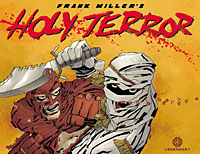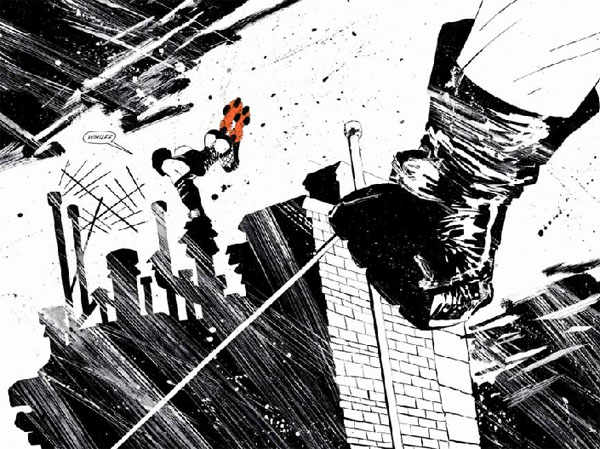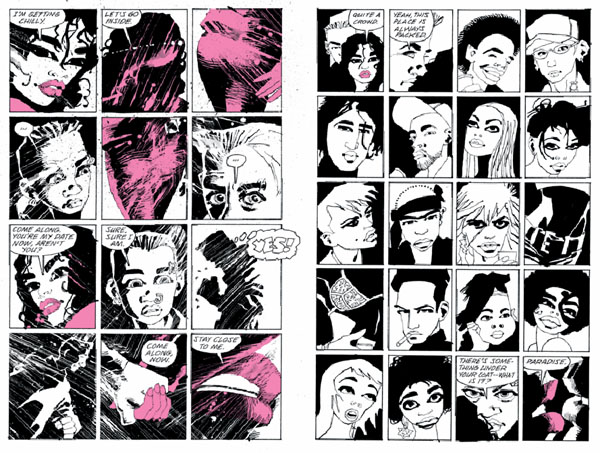 By Frank Miller
By Frank Miller
120 pages, black and white, with spot color
Published by Legendary Comics
Frank Miller made his name on comics like Daredevil, Batman: The Dark Knight Returns, Batman: Year One, and Sin City. Since then, though, his career has been anything but predictable; comics like 300, All-Star Batman and Robin the Boy Wonder, and Batman: The Dark Knight Strikes Back have all had their share of both praise and hate, plus his forays into directing with Sin City and The Spirit. So when Holy Terror was first announced, the idea sent eyebrows shooting up for miles. The actual book, I suspect, won’t let those eyebrows go down any time soon.
It’s hard to ignore the fact that Holy Terror was originally announced as Holy Terror, Batman!, a book to be published by DC Comics and having Batman go after Al-Qaeda. The collision of a pop icon superhero going up against the real world threat of a terrorist organization was a questionable decision at best, mashing up escapist fantasies with a real life, dark subject. It wasn’t an impossible feat to pull off to make it work, but it was one that would require a great deal of subtlety. Unfortunately, based on his recent comics, subtlety did not seem to be an adjective that Miller wanted attached to his comics.

Now officially not a Batman comic, Holy Terror sports a thinly disguised duo of characters that are called the Fixer and Natalie Stack (a cat burglar) but are hard to keep from calling Batman and Catwoman. Running across the rooftops of Empire City wearing S&M gear, we get phrases repeated over and over like mantras (the word "ass" shows up four times in the page where Natalie is splay-legged flying through the air, ass pointed firmly toward the reader), until the two fight and then get hot and heavy. (Eat your heart out, Catwoman.) Then the terrorist attacks begin, and the book alternates between caricatures of political figures from the past ten years, and the Fixer and Natalie killing terrorists. Over and over and over again.
As hinted at earlier, there is no subtlety. Miller said in past interviews that he viewed Holy Terror as "a propaganda piece" but I’m not entirely sure it hits that mark. This is less "rah rah this country is the best" and more of an exorcism from someone heavily invested in superheroes. I can understand how drawing Batman (and later, the Fixer) making everything right would be an emotional release. But in the same way that transcripts of role-playing game sessions rarely make good books, I remain unconvinced that a therapeutic session makes for a cohesive narrative.

Storytelling is all over the place in Holy Terror. A lot of the book (formatted in the landscape size that Miller used for 300) is told in single page splashes, and that’s where the book is (visually) at its strongest. They’re full of power and energy, and the combination of pools of blank ink and slashes of white across them result in a striking finished image. If Miller had just released a portfolio of 20 of these images (with no official attempt at sequential art) I can’t help but think that this would have been a stronger and better-received final product. Not all the splashes are perfect; as we get closer in, some of the pages come across a bit too muddled, with people’s limbs blending into their surroundings and some of the uglier faces I’ve seen in comics attached to the characters. The S&M gear for Natalie is never really explained (especially since she’s supposed to be on the run and blending in), and it ends up being a visual distraction. When the book every now and then delves into actual panels, they’re in many ways a shrunken down version of his splashes. Unappealing faces (I’m not sure when Miller stopped being able to draw them), and a mixture of strong techniques and questionable finishes.
Officially there’s no word on why Holy Terror stopped being a Batman story. It’s hard to ignore the fact from start to finish, though, especially when a police commissioner who is the spitting image of Jim Gordon rushes across the page. I can’t help but feel that DC Comics might be breathing a sigh of relief. The company has never courted controversy, and I think it’s safe to say that Holy Terror does its best to be controversial. Unfortunately, in doing so it appears to have lost sight of a lot of basic storytelling techniques. This is the Miller of The Spirit film, not Daredevil: Born Again. There are many Miller books I’m proud to keep in my library, but this won’t be one of them. I appreciate his need to get this idea onto paper, but I’m unconvinced that doing so made a decent book. Holy Terror can best be described as for Frank Miller completists only.
Purchase Links: Amazon.com | Powell’s Books
